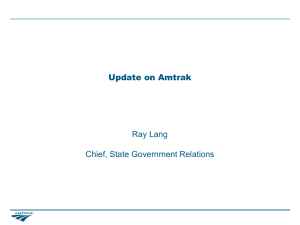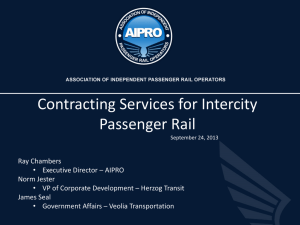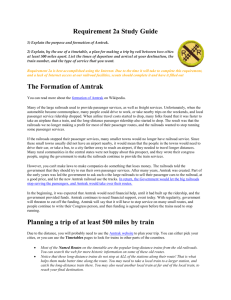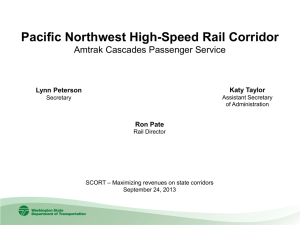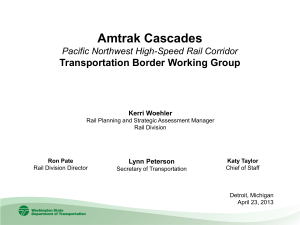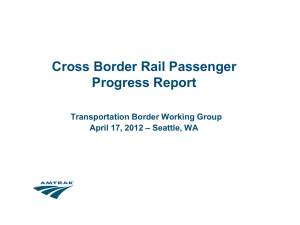Summary of Passenger Rail Investment and Improvement Act
advertisement
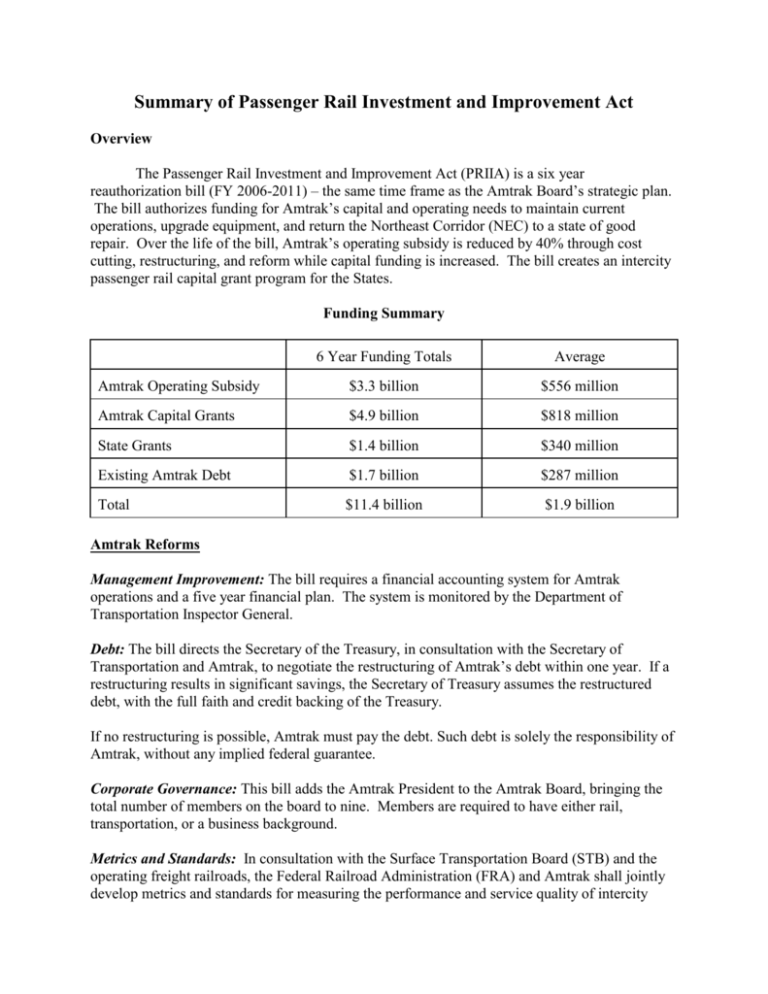
Summary of Passenger Rail Investment and Improvement Act Overview The Passenger Rail Investment and Improvement Act (PRIIA) is a six year reauthorization bill (FY 2006-2011) – the same time frame as the Amtrak Board’s strategic plan. The bill authorizes funding for Amtrak’s capital and operating needs to maintain current operations, upgrade equipment, and return the Northeast Corridor (NEC) to a state of good repair. Over the life of the bill, Amtrak’s operating subsidy is reduced by 40% through cost cutting, restructuring, and reform while capital funding is increased. The bill creates an intercity passenger rail capital grant program for the States. Funding Summary 6 Year Funding Totals Average Amtrak Operating Subsidy $3.3 billion $556 million Amtrak Capital Grants $4.9 billion $818 million State Grants $1.4 billion $340 million Existing Amtrak Debt $1.7 billion $287 million Total $11.4 billion $1.9 billion Amtrak Reforms Management Improvement: The bill requires a financial accounting system for Amtrak operations and a five year financial plan. The system is monitored by the Department of Transportation Inspector General. Debt: The bill directs the Secretary of the Treasury, in consultation with the Secretary of Transportation and Amtrak, to negotiate the restructuring of Amtrak’s debt within one year. If a restructuring results in significant savings, the Secretary of Treasury assumes the restructured debt, with the full faith and credit backing of the Treasury. If no restructuring is possible, Amtrak must pay the debt. Such debt is solely the responsibility of Amtrak, without any implied federal guarantee. Corporate Governance: This bill adds the Amtrak President to the Amtrak Board, bringing the total number of members on the board to nine. Members are required to have either rail, transportation, or a business background. Metrics and Standards: In consultation with the Surface Transportation Board (STB) and the operating freight railroads, the Federal Railroad Administration (FRA) and Amtrak shall jointly develop metrics and standards for measuring the performance and service quality of intercity train operations. Such metrics and standards shall include cost-recovery, on-time performance, ridership per train mile, on-board and station services, and the connectivity of routes. The Federal Railroad Administration shall publish a quarterly report on train performance and service quality. Route Methodology: The FRA must retain a consultant to develop and recommend objective methodologies for route and service decisions. The methodologies shall give consideration to cost recovery and on-time performance of existing routes, connections with other routes, transportation needs of communities not served by other public transportation, and the methodologies used by rail service providers in other countries. Amtrak shall consider adoption of the methodologies recommended by the consultant. Access to Amtrak Equipment and Services: States wishing to use operators other than Amtrak for the provision of state-supported services shall have access to Amtrak facilities for the purpose of operating that particular route. Northeast Corridor and Short-Distance Routes Northeast Corridor: Amtrak must develop a capital spending plan to return the NEC to a state of good repair by the end of 2011. The capital funds authorized in the bill are used to carry out the plan at a 100 percent Federal share. This bill establishes an advisory commission to provide advice and oversight of the NEC’s operations and infrastructure. The commission members represent Amtrak, the FRA, and each State in the NEC. The commission must develop a proposal for determining the proper costs and access fees for NEC passenger and commuter trains. If Amtrak and the States fail to implement the proposal, the STB is authorized to impose restructured fees for the users of the NEC. State-Supported Routes: Amtrak must develop, after consulting the States and the FRA, a uniform cost allocation methodology to assign costs and determine compensation for Statesupported services. Currently, States pay different rates depending on when their contracts with Amtrak were negotiated. If Amtrak and the States don’t implement the proposal developed by the commission, the STB is authorized to impose restructured compensation rates. Long Distance Trains Service Improvements: The FRA, in consultation with Amtrak, must develop system-wide performance metrics for all Amtrak services in 2006 to evaluate the financial and on-time performance, and customer satisfaction of each train. These metrics will be collected and published on a quarterly basis. In 2007, Amtrak is required to establish performance improvement plans for 5 long distance routes (1/3 of the 15 intercity passenger trains) with the worst performance. As Amtrak develops these plans, it must consider restructuring the route, improving on-board service, changing amenities such as sleeper car service and food service, and changing the frequency of the trains. In 2008, Amtrak must implement the plans. In future years, the remaining long distance routes will undergo the same restructuring process. Competitive Bid Program: The bill establishes a competitive bid program allowing freight railroads to bid for long distance trains. FRA administers the bid process. Any employees adversely affected by the cessation of the operation of a route will either be relocated to other positions within Amtrak, provided financial incentives in exchange for the voluntarily termination of their employment, or paid termination payments guaranteed under existing collective bargaining agreements. Other Provisions Service Improvements: The bill requires the STB to issue a quarterly on-time service report. If a train’s on-time performance record falls below 80% for two consecutive quarters or fails to meet other requirements set by the FRA, the STB must investigate the cause. The STB then recommends to Amtrak or a freight railroad how to fix the problems that cause the service delay. If the STB determines that delays to passenger trains are the result of freight railroads not providing priority access to Amtrak, as required under law, the Board may take appropriate action to enforce priority access. Capital Grants: The bill creates a new State Capital Grant program for intercity passenger rail capital projects. The program makes grants to a State, or a group of States, to pay for the capital costs of facilities and equipment necessary to provide new or improved intercity passenger rail. The federal match is 80 percent. Projects are selected by the Secretary of Transportation based on economic feasability, expected ridership and other factors. . State Rail Plans: The bill establishes a State rail planning process. New projects funded by the grant program must be on the plan. Security: The bill includes the Amtrak and passenger rail security and tunnel life/safety provisions from the Rail Security Act of 2004 that passed the Senate. Bond Financing: Includes a program at the Department of Transportation to allow States and Amtrak to issue tax credit bonds for capital associated with inter-city passenger rail. Projects have to be on the State rail plan and Amtrak projects have to be on its 5 year plan. For Additional Information Contact: Chris Bertram (Majority) Staff Director Subcommittee on Surface Transportation and Merchant Marine (202) 224-4852 Stephen Gardner (Minority) Professional Staff Member Subcommittee on Surface Transportation and Merchant Marine (202) 224-9000 February 16, 2016 (9:35PM) S:\WPSHR\MSTM.rep\109th\Amtrak\Amtrak Provision Summary3.wpd
